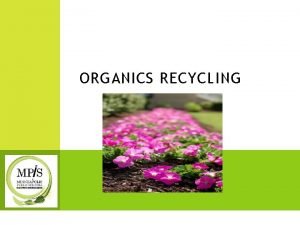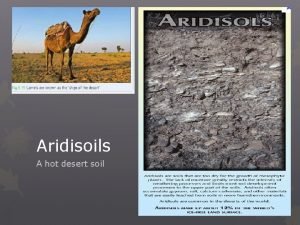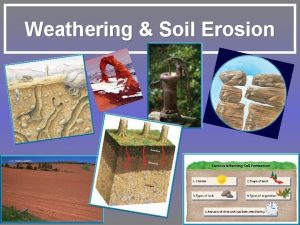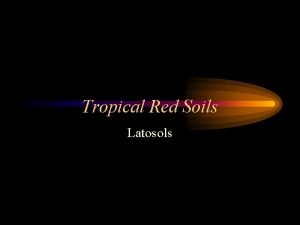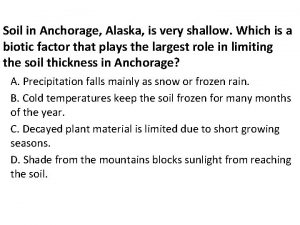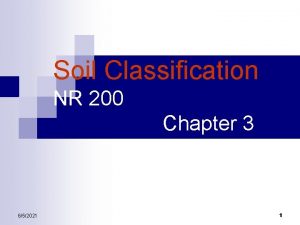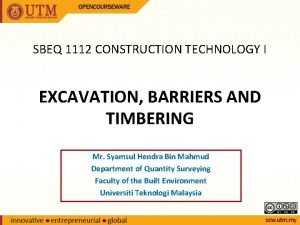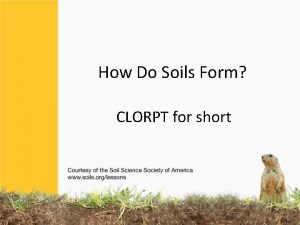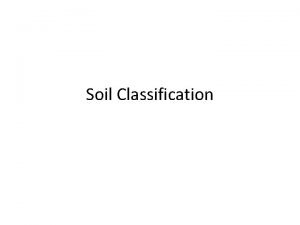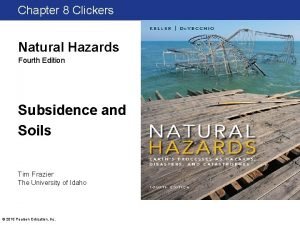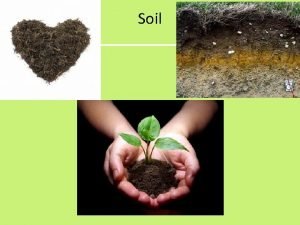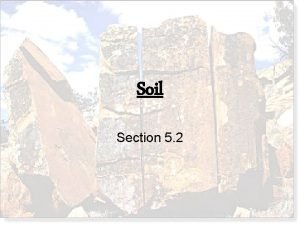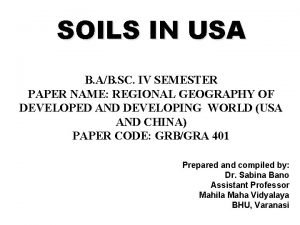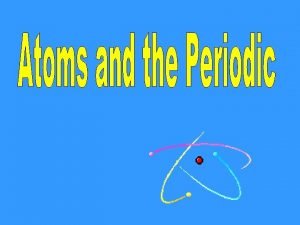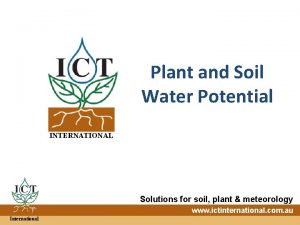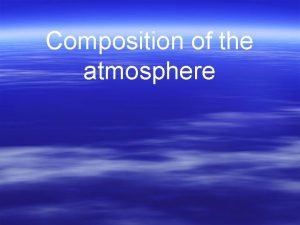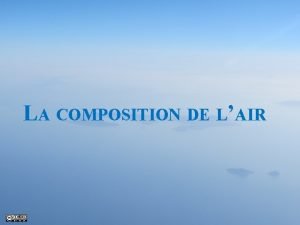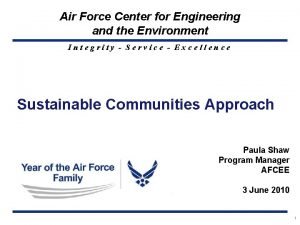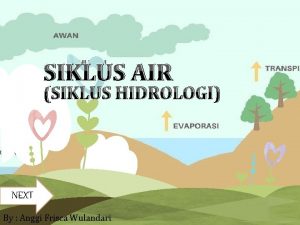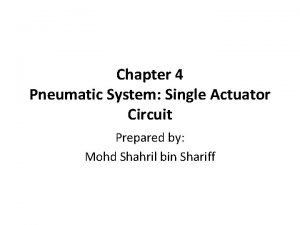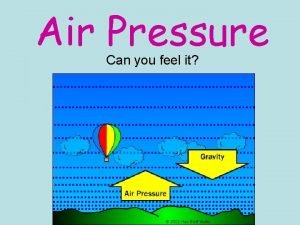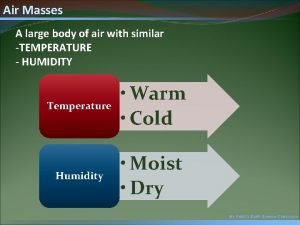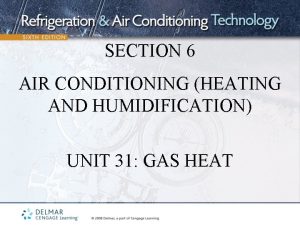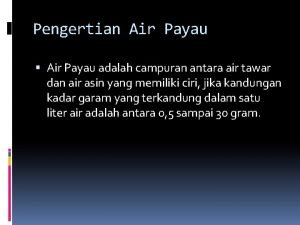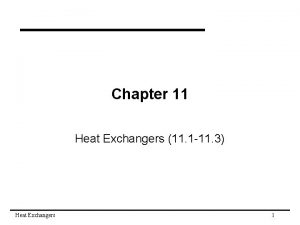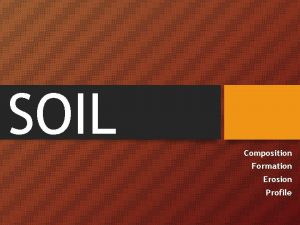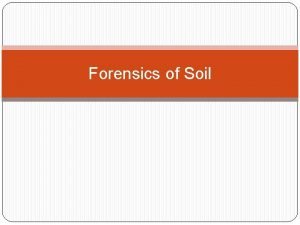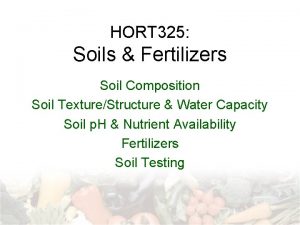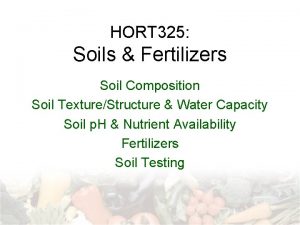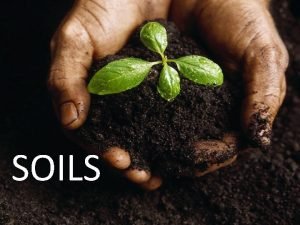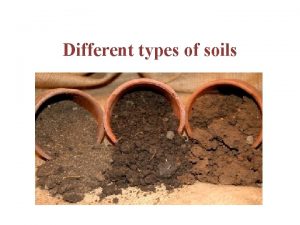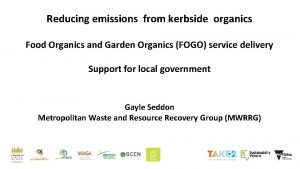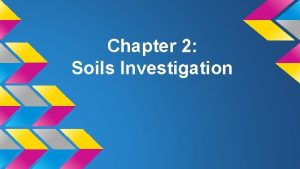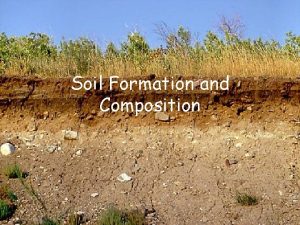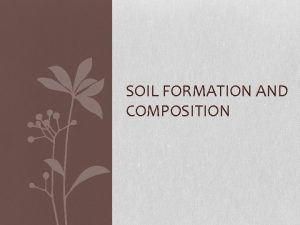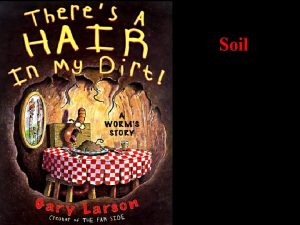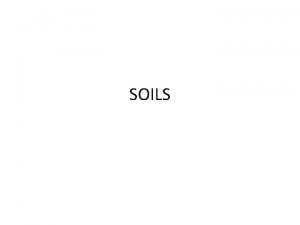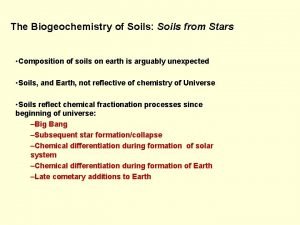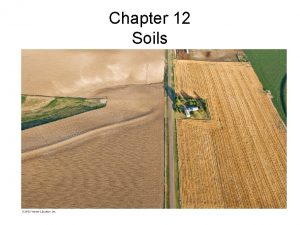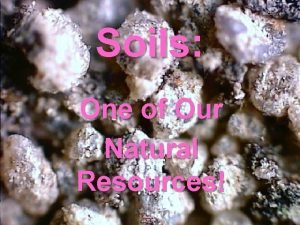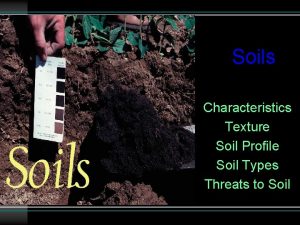Chapter 14 Soils Environment soil composition organics air





![Soil fertility nutrients available for plants natural parent material - flood deposits, till, bedrock] Soil fertility nutrients available for plants natural parent material - flood deposits, till, bedrock]](https://slidetodoc.com/presentation_image_h2/bcbfbaf0674e5fa99cddf88991ad337e/image-6.jpg)




































- Slides: 42

Chapter 14: Soils & Environment

soil composition organics air water weathered earth materials (parent material) mechanical weathering smaller, rounder pieces (if moved) chemical weathering feldspars and water = clays calcite - dissolves organics - dissolve - acidify water quartz - usually left behind transported vs residual

formation dominated by downward movement of water weathers parent material moves dissolved substances downward

Soil profile - fig p 440 created by downward movement of water horizons O - organic humus little or no parent material A weathered parent material w/ organics zone of leaching E - few organics or iron B - zone of accumulation Bt - clay enriched Bk - calcium enriched - calcium coats K calcium dominated

soil properties color related to composition organics - dark yellow iron - red or grey - dominates calcium - light or white describe wet - use charts texture grain size distribution (among fraction <2 mm estimate in field - measure in lab structure peds granular, blocky, prismatic, platy >clay
![Soil fertility nutrients available for plants natural parent material flood deposits till bedrock Soil fertility nutrients available for plants natural parent material - flood deposits, till, bedrock]](https://slidetodoc.com/presentation_image_h2/bcbfbaf0674e5fa99cddf88991ad337e/image-6.jpg)
Soil fertility nutrients available for plants natural parent material - flood deposits, till, bedrock] organics climate temp precip – rain supports vegitation – leaches nutrients • Northern IL forests vs rainforests humans alter veg

Water in soil saturated vs moist vs dry What effect does soil moisture have on soil cohesion? sand (moist vs wet vs dry clay (wet vs dry flow saturated - hi pressure to lo pressure unsaturated - film of water attached to grains

Soil classification taxonomy - based on physical and chemical props of soil morphology nutrients organics classification methods order, suborder, great group, subgroup, family, series focus on ag use universal soil classification focus on size and composition used by engineers

What are the engineering properties of soils? How will soil affect building based on particle size, compostion, water content behavior based on water content solid/plastic/liquid plastic limit, liquid limit - diff is plasticity index take soil, add water until ribbons form, flows wet weight - dry weight over dry weight strength - how well does soil hold together and support cohesion of particles - esp for fine grain molecular and electrostatic forces moisture

Land use and soils What are the causes and effects of soil erosion? landscape modification resulting in increased erosion, esp during modification urbanization – sharp sed load increase followed by long term decrease timber harvests – removes cover and roots • clear cut vs select cut • equipment = disturbance agriculture - tilling and grazing – exposes soil to wind and water – management - wind breaks, contour farming, no-till, terracing, strip cropping, CRP, buffer zones – other effects

Soil pollution addition of toxic or carcinogenic substances to soil factors mobility solubility attraction to clays decompostion – chemical (agrichems – biological presence of – oxygen – water – microorganisms

What is desertification? conversion of productive land to desert factors deforestation soil erosion poor drainage of irrigated land overdraft of water accelerated by drought stress affects long term hydrologic cycle - climate North American example water tables salinization of soil and near-surface soil water from irrigation reduction of surface water in streams and lakes

Soil surveys and land use planning soil maps soil cross-sections soil descriptions inc grain size distribution moisture content strength may rate soils agriculture, prime, important etc housing industry forestry

Chapter 16: Global Climate Change

Global change Earth has been changing since beginning early pre. Cambrian (over 4. 5 billion years) Scale of variability - days to >10, 000's yrs Causes of variability Sun - output, angle Earth rotation speed (slowing) continental movements Volcanic output Life - O 2 + CO 2 cycles, humans

Research priorities is there change? on what scale? what are the causes? what are the affects?

Composition of atmosphere N - 78% O 2 - 21% Ar – 0. 9% CO 2 – 0. 03% other – 0. 07% CH 4, 3, CO, NOx, SOx, H 2 S, etc water – 0 to 4%

Energy balance almost all energy ultimately from sun earth’s energy cycle reflects 30% absorbs 70% (visible & IR) emits IR (as much energy as it receives)

Earth’s temperature based on sunlight received amount reflected atmospheric retention: “greenhouse effect” H 2 O vapor, CO 2, CH 4, CFC’s natural process increasing in atmos due to humans CO 2 changes highs - interglacial periods - 125 K yrs ago and now current increase started in 1800's releasing stored CO 2 from rx other changes

Tools to study global change Geologic record Real time Mathematical modeling - global circulation models

Earth’s Climate on average: warmer than present current ice age - 2 MYA to present last glacial advance ended 10, 000 yrs ago gradually warming since anthropogenic effects

Potential Effects of Global Warming climate change more rain more violent storms sea level rise complex responses (unpredictable)

Chapter 17 Geology, Society, and the Future: Selected Examples

Geology may influence diseases and death rates acute vs chronic response Element requirements for life Metals - H, Na, Mg, K, Ca Non-metals - C, N, O, P, S, Cl, Fe hemoglobin Trace - Fluorine, Cr, Mn, Cobalt, Cu, Zn, Selenium, Molybdenum, Iodine

Concepts of waste management dilute and disperse concentrate and contain integrated waste management

integrated waste management resource recovery goal: zero waste production recycle reuse reduce - pay as you throw move waste around sequential land use (subsequent uses must be limited) front end controls more efficient processes less packaging

waste stream Waste types industrial construction demolition municipal commercial medical Composition paper hard waste plastics metals food glass wood

Disposal methods on site - any method sewer (note on-site in book incineration produces ash and air waste composting – recycles organic waste landfill - engineered site

Landfills considerations leachate methane rodents & pests active face - blowing trash site selection local approval IL PCB - legal requirements IL EPA - engineering requirements

Landfills site design - fig p 544 geology liners leachate collection and treatment waste types accepted monitoring landfill conditions migration routes cells subsequent monitoring and design

Hazardous Chemical Waste waste byproducts uncontrolled sites - CERCLA controlled sites - RCRA responsible management cradle to grave generators transporters storage treatment disposal

Environmental Impact Statement EIS summary purpose and need rigorous comparison of alternatives description of environment discussion of consequences identification of issues and alternatives record of decision alternatives which are preferred rationale avoidance and/or mitigation required

Site selection and evaluation physiographic determinism design with nature minimize landscape alteration focus - will site provide needs of use process - fig p 555 collect data recon likely sites collect addn’t data magnitude and importance of geologic limitations and possibilities

Methods of site selection and evaluation cost benefits analysis physiographic determinism use map overlays (to show +’s and -’s) choose best site use physical, social, aesthetic, etc Environmental geology mapping interpretive may focus on anticipated uses content based on user GIS

considerations of site selection and evaluation Landscape aesthetics - scenic resources hard to evaluate - subjective uniqueness - overall scenic sequential land use - fig p 556 multiple land use - fig p 557

Environmental Law: Basis Trust doctrine each generation has a moral responsibility to provide the next with healthful, productive and aesthetically pleasing surroundings Declaration of Independence Government protects each persons right to life, liberty, and the pursuit of happiness

Environmental Law: Basis Constitution Preamble - “promote the general welfare, and secure the blessings of liberty to ourselves and our posterity” Article 1, section 8 (Congressional powers) “to regulate commerce among the several states” “toprovide for the common defense and general welfare of the US”

Environmental Law: Basis Constitution 9 th amendment “The enumeration in the Constitution, of certain rights, shall not be construed to deny or disparage others retained by the people” 5 th amendment No person shall bedeprived of life, liberty, or property without due process of law; nor shall private property be taken for public use without just compensation 10 th amendment “The powers not delegated to the US by the constitution, nor prohibited by it to the states are reserved to the states respectively, or to the people” 14 th amendment, section 1 extends 5 th amend to states

Environmental Legislation: Federal Refuse act of 1899 - unlawful to discharge refuse into tributaries of navigable waters Permit from Sec of Army National Environmental Policy Act focused attn on potential env degradation provided a framework for proj eval (EIS increased efforts to protect env in US Clean Water Act & Clean Air Act CERCLA & RCRA

Environmental Law: local land use planning and law zoning

Environmental Law: controversies highest and best use most profitable use takings conflict with treaties and trade agreements

Environmental Law: International Law of the seabed up for grabs no treaties 20 mile limit treaties trade agreements
 Midwest organics recycling
Midwest organics recycling Air higroskopis adalah
Air higroskopis adalah Living soil vs dead soil
Living soil vs dead soil What are the four spheres of the earth
What are the four spheres of the earth Soil pie chart
Soil pie chart Desert soil layers
Desert soil layers Volume composition of soil
Volume composition of soil Apes soil frq
Apes soil frq The rate of weathering depends upon the area's ____
The rate of weathering depends upon the area's ____ Latosol soil
Latosol soil Soil
Soil Anchorage soil
Anchorage soil Prairie soils (mollisols) are _______.
Prairie soils (mollisols) are _______. Continuous tubular rails
Continuous tubular rails Clorpt soil
Clorpt soil What is soil
What is soil How does the study of soils help evaluate natural hazards?
How does the study of soils help evaluate natural hazards? Components of soil
Components of soil Soil that forms on unconsolidated deposits is called
Soil that forms on unconsolidated deposits is called Porosity of soil
Porosity of soil Forensics
Forensics Pedocal soils
Pedocal soils Chapter 12 section 1 what causes air pollution answers
Chapter 12 section 1 what causes air pollution answers Chapter 12 air section 1 what causes air pollution
Chapter 12 air section 1 what causes air pollution Financial environment of business
Financial environment of business Undesired change in air water soil
Undesired change in air water soil Food air and clothes
Food air and clothes Sap flow
Sap flow Composition of air by mass
Composition of air by mass Air composition
Air composition Air force center for engineering and the environment
Air force center for engineering and the environment Betonisasi jalan-jalan sanggup mengganggu daur air lantaran
Betonisasi jalan-jalan sanggup mengganggu daur air lantaran Yang termasuk pelarut anorganik adalah
Yang termasuk pelarut anorganik adalah Exhaust air throttling
Exhaust air throttling Can you feel it in the air in the air
Can you feel it in the air in the air Large body of air
Large body of air Two cold air masses converge on a warm air mass
Two cold air masses converge on a warm air mass Put your right hand in the air
Put your right hand in the air Air atmosfer atau air materai
Air atmosfer atau air materai Is methane lighter than air
Is methane lighter than air Right hand in the air left hand in the air
Right hand in the air left hand in the air Arti air payau
Arti air payau Parallel flow heat exchanger
Parallel flow heat exchanger
